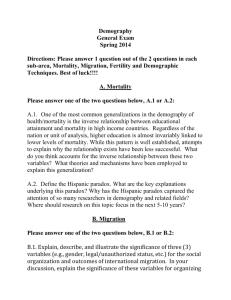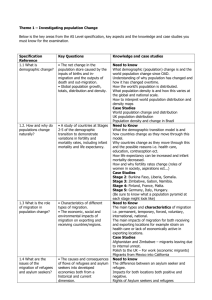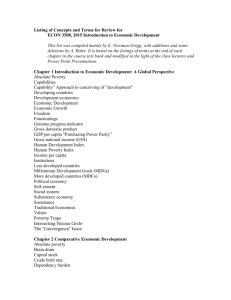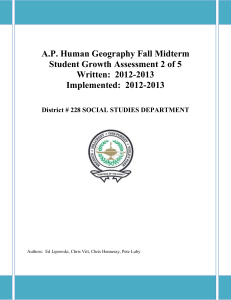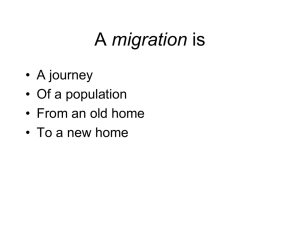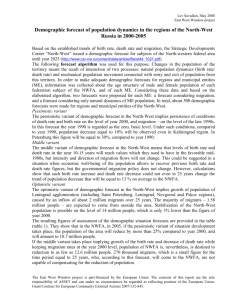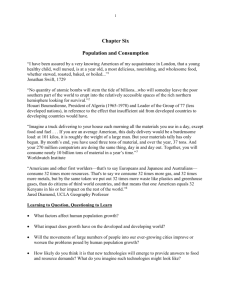Chapter 2: Population and the World Economy
advertisement
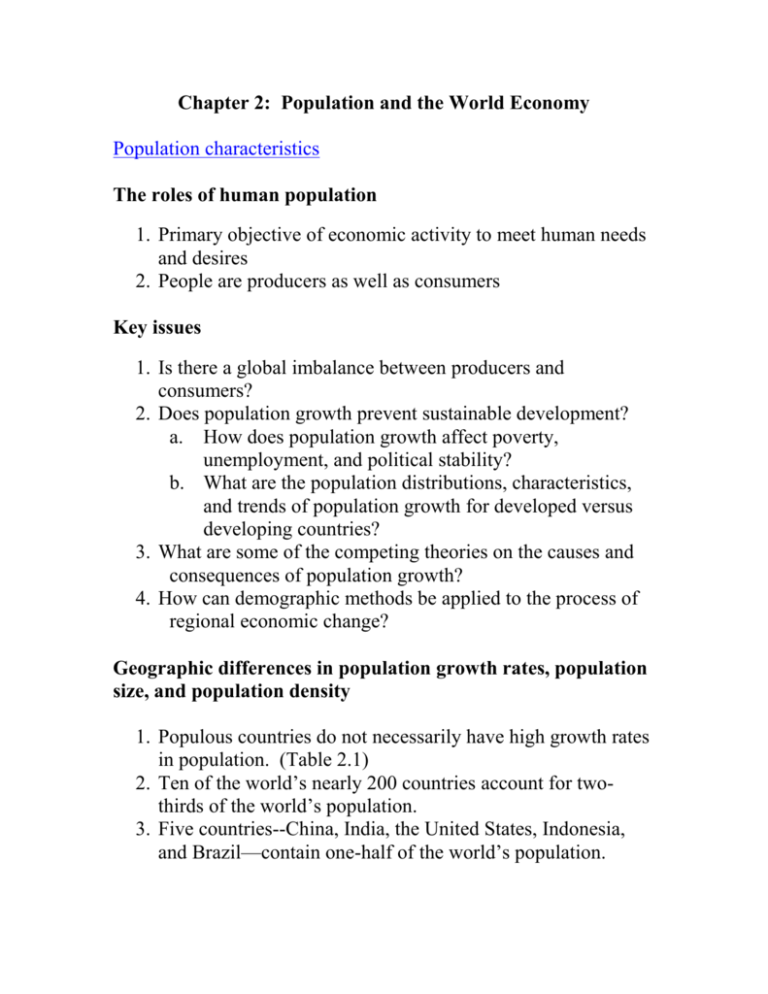
Chapter 2: Population and the World Economy Population characteristics The roles of human population 1. Primary objective of economic activity to meet human needs and desires 2. People are producers as well as consumers Key issues 1. Is there a global imbalance between producers and consumers? 2. Does population growth prevent sustainable development? a. How does population growth affect poverty, unemployment, and political stability? b. What are the population distributions, characteristics, and trends of population growth for developed versus developing countries? 3. What are some of the competing theories on the causes and consequences of population growth? 4. How can demographic methods be applied to the process of regional economic change? Geographic differences in population growth rates, population size, and population density 1. Populous countries do not necessarily have high growth rates in population. (Table 2.1) 2. Ten of the world’s nearly 200 countries account for twothirds of the world’s population. 3. Five countries--China, India, the United States, Indonesia, and Brazil—contain one-half of the world’s population. 4. Only three—the U.S, Russia, and Japan—of the top ten most populous nations are considered developed. 5. Population density is generally the highest is small citystates or islands, such as Singapore. 6. Not all crowded countries are poor. Of the top ten most densely populated areas, three are developed and three others are NICs. (Table 2.2) 7. Population density varies considerably within countries as well as across countries. Factors Influencing the Distribution of Population 1. Physical environment—concentration at low elevations, milder and more humid climates. Air conditioning, heating, water storage, and irrigation are technologies that have offset the effects of climate extremes. 2. Cultural effects and economic systems within a historical context have effects on fertility, mortality, and migration. 3. Fertility rates decrease with economic development. 4. Mortality rates decrease with economic development 5. Economic conditions, public policy, and demographics affect migration rates. 6. Urbanization generally corresponds with the level of economic development. http://www.acdi-cida.gc.ca/xpress/dex/dex9704.htm a. Development of hierarchy of cities b. The role of agglomeration economies and economies of scale reinforce lower transport costs 7. Urbanization in the developing world is not accompanied by a rapid rise in prosperity. Why? a. Excess concentration at large, primate cities b. Diluting capital resources c. Congestion, slums, and deteriorating services d. Lack of employment opportunities Mapping exercise The geographic distribution of various social characteristics Population Change over Time 1. The demographic transition model in developed countries a. The industrial revolution first lowered the death rate with higher standard of living that disproportionately affects the very young (same effect as higher birth rate). b. Second, the birth rate eventually fell with increased motivation for families to limit family size. c. The surge in population in between these two periods added to an explosion in the natural rate of population growth. d. Eventually, demographic transition is completed that results in births equal to deaths. e. Only North America, Europe, and East Asia have moved completely through the demographic transition. 2. Application of model to developing countries a. Developing countries in Asia and Latin America have undergone the population explosion phase and are beginning to slow their natural rate of population growth, but Saharan Africa’s birth rates have not decreased significantly. (Saharan African society places cultural and religious emphasizes on ancestry and descent with children considered as economic assets to continue the family lineage.) b. But, even with lower fertility rates absolute population size will continue to grow because of the large size of the base population. c. In the next 25 years almost all of the increase in world population will occur in developing countries. 3. Fertility and mortality a. A higher survival rate of infants results in more adults b. More working, healthy adults adds to labor productivity c. Eventually, taking care of retirees becomes an increasing problem with greater life spans. 4. The demographic equation a. Population at time 2 = population at time 1 + births – deaths + in-migration less out-migration b. Net in-migration adds even more to overall population because of increased children of immigrants c. In developed economies net migration becomes the most important determinant of population growth. 5. Causes of migration a. Most people move for economic reasons, although it may be voluntary or involuntary (African slave trade in this country, the deportation of British convicts to the U.S. and Australia,) b. Economic motives are sometimes divided into “push” and “pull” factors. c. Push factors are to leave places of economic hardship d. Pull factors are to seek areas of economic opportunity 6. The economics of voluntary migration Migration and Comparative Advantage a. Classical migration theory based on wage differentials between countries (say U.S. versus Mexico) b. Labor migration narrow wage differentials subject to relocation and migration costs that are capitalized over the remaining work life of the mover. Long distance moves are less likely than shorter distance moves. c. The lack of convergence is due to imperfect knowledge, cultural differences, and institutional barriers, such as immigration laws. d. Increased urbanization of a destination region is expected to increase its attractiveness for potential migration, reducing uncertainty and increasing the probability of a “beaten path” by earlier immigrants. 7. Consequences of Migration a. Migrants tend to be younger, more ambitious, and better educated than the population of their origin and frequently the population of their destination. b. Conflict and ability to adjust to new region is greater for poor migrants than for the relatively well educated. c. Guest workers generally contribute enormously to the economy in which they locate. d. Migration patterns are generally divided into subcategories: i. Internal (origin within the country) or external (origin outside the country) ii. Among externals: inter or intra continental iii. Among internal: interregional, rural-urban, or inter-metropolitan. 8. Trends in Migration a. Prior to the Great Depression intercontinental migration of Europeans to the U.S. dominated. b. Since WWII the tide of migrants is overwhelmingly from developing to developed countries. c. The era of heavy intercontinental migration is over. d. In the highly urbanized U.S. inter-metropolitan migration is increasingly important. Population Structure 1. The age-sex structure affects the labor force, demand for education facilities, retirement and medical systems, etc. 2. Population pyramids graphically represent the structure among 5-year age groups from the youngest to the oldest group. 3. Country population pyramids: http://www.census.gov/ftp/pub/ipc/www/idbpyr.html 4. The can be used to forecast population based on cohortsurvival method. 5. Developing countries have a squat, triangular profile. 6. The U.S. has slimmer profile but with a bulge at the waist in 1990 due to the baby boom after WWII. 2000 pyramid reflects children of baby boomers. http://www.ac.wwu.edu/~stephan/Animation/pyramid.html 7. Zero (or negative) population growth with immigration restrictions over a long period results in a slim profile with a potential labor shortage. Demographic Characteristics 1. Human capital has characteristics that are either achieved (education, occupation, etc.) or ascribed (race, sex, etc.) 2. Education is the most important determinant of demographic trends, as it affects fertility, mortality, and migration. 3. Labor force participation is increasing in the tertiary sector in the U.S. economy at the expense of primary activities, particularly agriculture. 4. Per capita income is the most familiar index of economic development that reflects residents’ well-being and capacity to consume. Economic Growth and Development 1. The three-corned debate over population growth and development centers on (a) the need for population by nationalists, (b) the Marxist view that population growth per se does not hamper economic development, but rather unjust 2. 3. 4. 5. social and economic institution, and (c) the neo-Malthusians that population growth can wipe out economic gains. Economic forces include the need for population to create economies of scale that increase efficiency. However, excessive population growth will exhaust resources and reduce living standards. The carrying capacity, or population size that can be maintained indefinitely, depends on level of living chosen by the country. Modern growth theory emphasizes the roles of capital formation and new technology to achieve higher carrying capacity for an economy. The age structure of population affects the size of the labor force and the saving rate necessary for investment. Demographic Forecasting at the Firm and City Level 1. Firms also have a life span—birth, growth, maturity, die, and migrate. 2. Organization ecology or firmography focuses on the advantages of geographic isolation (avoiding competition) versus proximity (agglomeration economies) in the location and survival of a business firm. 3. Firms use target marketing base on GIS to profile market segments for a particular business. (Examples in pp. 87-91) 4. The demographics of the firm are being affected by two major factors—technology and generation. a. Technology is restructuring or reengineering the workplace environment to create the flexible economy. b. Generational is the role of baby boomers on consumer spending, labor productivity, and political power. 5. Corporations are no longer responsible for a worker’s life, career, and retirement, but responsibility is shifted to the individual. 6. Stable, hierarchical families are giving way to mobile, multicareer, fast changing, flexible families in much the same way in order to achieve in the job market. 7. Firms and households are projected to increasingly locate in excerbs proximate to larger metropolitan areas if they are to reduce the cost of living and increase the quality of life. 8. Customization and flexibility to individual’s demands and needs will be keys to a companies success requiring creativity in products and services. Smaller, entrepreneurial firms will create more jobs than larger firms. 9. The customized/flexible economy is the rough opposite of the standardized economy of the past. Individual’s work is small, self-managing teams focused on a particular need or customer problem. Large inventory bloats are reduced by faster response to customers in niche markets (Example of Dell Computer Corporation) Demographics for City Planning 1. Cities need to begin with a regional growth forecast (RGF) based on GIS to determine level and location of population, the need and location of schools, hospitals, fire and police protection, and sewage and water treatment plants, zoning for land uses, transportation plans, projected housing needs, projected energy demands, air quality, etc. 2. Planning seeks to coordinate regional goals and policies with general plan & development patterns subject to intergovernmental review procedures. Demographic Techniques
